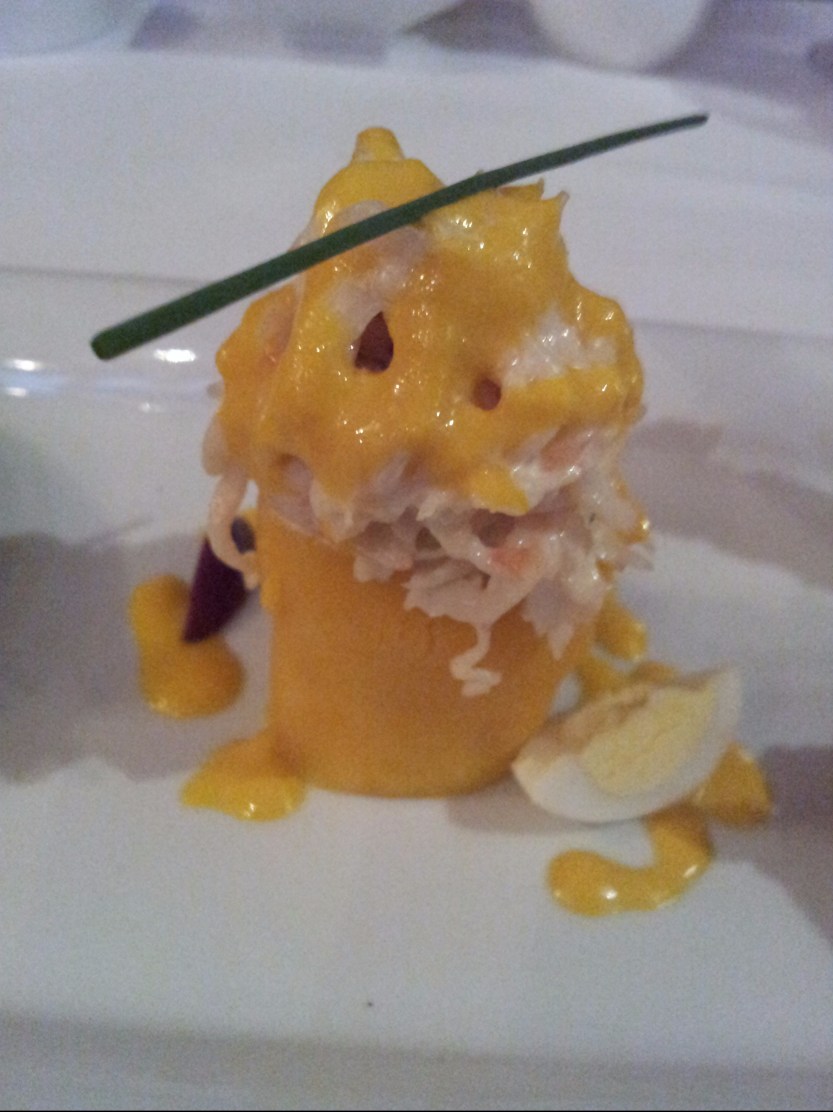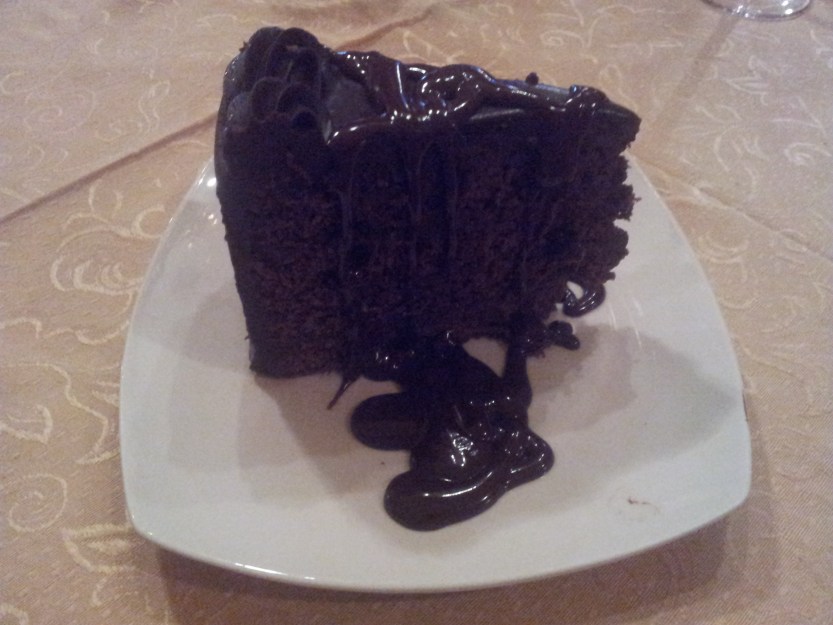Peruvian cuisine has a great culinary reputation throughout South America and I’d have to agree that the best food I had in Chile and Argentina was made by Peruvian chefs. Ingredients from Peru have travelled much further abroad too, for instance, Italy’s beloved San Marzano tomato was a present from the King of Peru to the King of Naples. And of course Peru is where the potato was domesticated about 7,000 – 8,000 years ago, before being brought to Europe by Spanish explorers. If you are near Lima, you can even go to the International Potato Centre where they have over 5,000 varieties. I can’t wait to go visit the country one day but it the meantime I had to make do with these places.
Astrid y Gaston (Advanced A-), Antonio Bellet 201,
Gaston is a celebrity chef from Peru and Astrid is his Swiss wife. They have eight restaurants all around the Spanish speaking world so it is highly unlikely that they will be doing the cooking.
Anyone who sets themselves up to be the best is going to take a lot of flak as several negative reviews on the net show. Although they are in a minority, it’s true that if you make the wrong choice of a main course, you will probably get a bad impression. Some of the criticism on Trip Advisor is unfair however, for example people who get upset about waiters asking for a tip, which happens in every restaurant in Chile. The moaners need to understand that in Chile (like the US) this is how waiters make their money as their set wage is really low. At least they ask if it’s ok first.
Anyway, with regards to the food, I think the guaranteed way to enjoy this fusion restaurant is to go for the tasting menu so you will get at least a few things you enjoy, if not all of them. It’s reasonably priced in my opinion; I paid $38,000 (about £55) for five courses, which included the optional wine matching add on. Each of the five glasses (all Chilean wines) I had were excellent.

Also, make sure you reserve as it’s very popular. I got in by reserving a table for when they opened at 8pm on a Monday. Perhaps ask to be seated in the main room where you can see the chefs at work in the glass-walled kitchen, rather than the upstairs which is a bit dark and out of the way.
While perusing the menu and munching on their excellent bread, I had an Aquaymanto (A)…  …a Pisco Sour cocktail made with the addition of juice from Physalis berries from the Peruvian mountains, here stored in honey which the barman let me try a spoonful of. The orange berries in their papery husks are sometimes used as decoration for salads and other dishes which is where you might have seen them before.
…a Pisco Sour cocktail made with the addition of juice from Physalis berries from the Peruvian mountains, here stored in honey which the barman let me try a spoonful of. The orange berries in their papery husks are sometimes used as decoration for salads and other dishes which is where you might have seen them before.

The starter was four samples of other starters from the menu. My favourite (A+) was the Camarones Crocantes, Ecuadorian king prawns deep fried with panko breadcrumbs with orange-honey sweet and sour sauce.
With this were Ostiones, a Peruvian scallop covered with a citrus foam, something I’m not keen on usually but this was ok (B). 
My least favourite was Nobles Causes del Peru, a thick yellow puree of mashed potatoes and lima beans, which was tasteless (C), but topped with Chilean king crab, which was great (A).

Finally, a Classic Ceviche of white fish, red onion and red pepper, which was fine (B) if nothing special.
 With this, a glass of excellent ‘Nimbus’ Sauvignon Blanc from Casablanca 2010 (A). The sommelier told me about the background of each wine when he brought it, excellent service.
With this, a glass of excellent ‘Nimbus’ Sauvignon Blanc from Casablanca 2010 (A). The sommelier told me about the background of each wine when he brought it, excellent service.
Next a fish course of Salmon Confitado (creamy risotto with zucchini, aubergine, bell pepper and caramelised shallot (I got one tiny square of each) with a topping of rocket and watercress. The forkful with the shallot was the best (A) and the salmon skin was delicious but the rest fairly mediocre (B).

The ‘Las Brisas’ Pinot Noir from Leyda went well with this (A).

Following this a spaghetti dish in yellow sauce whose composition (it looked like tomato and passion fruit??) eludes me sorry, but again covered with a big glob of frothy green foam, which made me wonder if the chef didn’t like me (sorry but that’s always my first thought!).

It was ok (B) but I was particularly blown away by the wonderful Carmenere ‘Casas Patronales’ 2009 Reserva from the Valle del Maule D.O. (A+).

For the meat my least favourite dish; Corderito de la Patagonia, the famous lamb (B) ‘cooked and glazed in its own juices’ with a brackish Adobo sauce (C-) (a marinade of vinegar, tomatoes and spices) and topped incongruously with a quail’s egg.

With this some ‘native’ chips, which I took to be sweet potato (C) and a scoop of rice cooked with peas and kernels of giant maize, with the rice taking on the taste of the corn, which was delicious (A).

The Cabernet Sauvignon ‘Vielles Vignes’ 2009 from Chateau Los Boldos was another good match for the meat (A).

Finally for dessert, Suspiro (Peruvian soft toffee) served with a raspberry sorbet (B), Arroz con Leche (rice pudding, never one of my favourites) (C).

They also gave me Picarones (soft doughnuts) with vanilla icecream, bland individually but great in combination (A).

With this an excellent Moscato de Alexandria by cantina Tamaya called ‘Sweet Goat’ from the Valle del Limari D.O., the only dessert wine I had while in Chile and a very good one (A).

So all in all, a very good, but not fantastic experience, except for the wines which were exemplary,
After all this, I retired very happily to the bar to see what they had in the way of digestifs. I went with the obliging bartender’s choice of Chilcano de Pisco, a mix of Pisco, limon, angostura bitters and ginger ale, which was very good (B+) if a bit long for my very full stomach.

The bartender also let me try sips of both Chilean and Peruvian piscos, both excellent but tasting quite different. Apparently the Chilean variety is usually dark as it tends to be aged in oak, whereas the Peruvian type is always clear as it is distilled in copper and aged in glass or steel. It was originally distilled by Spanish immigrants living in wine producing areas as a replacement for aguardente from the home country (read more about the history and differences here). Although there is a Peruvian city called Pisco, the name probably comes from the pots used for making it.

There are many cocktails that can be made from Pisco but I tended to stick with variations of the Pisco Sour, the ‘national cocktail’ of both countries, or you could have it with coke which goes by the unappetising name of Piscola in Chile.
Barandiaran (Intermediate B), Manuel Montt 309-315, Tel. 236 6854
Part of a chain (see also next Bellavista post) of mid-range, straight up Peruvian restaurants, this branch is located in an atmospheric old building in an older part of Providencia. It’s best to book ahead to make sure you get a table in the nice garden out back as the inside can be a bit stuffy. They have good lunch time deals apparently but I went for my evening meal.
To be honest I had a better meal in their Bellavista restaurant but maybe this was because I ignored the waiter’s advice and made my own ill-informed choice of Filete al Cilantro, that is, a grilled tenderloin beef steak (B) in a coriander sauce (C-) made with a reduction of white wine and beer, which really didn’t work for me as the coriander was too overbearing.

It’s hard to know which dishes to choose from a menu when you have no experience of the cuisine. Guinea pig (cuy)was one of the options but I wasn’t in an adventurous mood. The Casas Patronales 2010 reserva Cabernet Sauvignon I had to go with the meat was ok (B) but it didn’t do all that much for me.

In need of cheering up I went for a slab of chocolate cake, which did the job, but was so big I couldn’t finish it, very unlike me.

 Wanting some inspiration, I asked the barkeep for an alternative digestif and he came up with pisco mixed with Licor de Manzanilla (Camomile) which was a new one on me, and quite interesting (B) but I won’t be rushing to have it again.
Wanting some inspiration, I asked the barkeep for an alternative digestif and he came up with pisco mixed with Licor de Manzanilla (Camomile) which was a new one on me, and quite interesting (B) but I won’t be rushing to have it again.


Total spent $17, 500, less than £25.
Osaki (Intermediate A), Santa Beatriz 135 NOW CLOSED!
Another Japanese-Peruvian cerviche and sushi restaurant but less pretentious and much, much cheaper than its flash rival Osaka (see Vitacura post) and with better food.
I started with the Ceviche Classico, which here involved sea bass with red onion marinated in Leche de Tigre (marinade of fish, lime juice and aji pepper), cameote glaseado ( sweet potato boiled with sugar), steamed choclo (giant maize) and another kind of sweetcorn which was very hard (perhaps fried?) and garnished with a couple of prawns. It was very nice (B+) but I’m not sure about the fried maize kernels whose crunchy texture jarred with the softness of the rest of the dish (texture is very important in Japanese cuisine).

After this a tray of Salmon Maki, a roll of fried prawns encrusted with quinoa (a grain originally from Peru), cream cheese, avocado, topped with smoked salmon and doused with teriyaki sauce, which was sublime (A), if a little sweet (but not overly so). Watching the chef make it was great fun too.




Next, Terodito Tradicion (B+), thinly sliced Cojinova (Palm Ruff in English, the Chef’s favourite fish for its flavour) with a ‘crema’ of yellow Aji peppers, chalaquita criolla’ (a kind of salsa?), coriander and lime sauce and the requisite hard kernels of maize, which I passed over.

I was pretty stuffed by then but found room for an amazing complimentary amuse bouche (A), the ingredients of which the chef (whose English was excellent) found hard to explain, although it seemed to involve a salsa and some banana.

To drink I had a couple of Austral cervejas…

…and to finish a Pisco with Fernet (Italian bitter, very popular in Argentina/Chile), not something I usually like but this was very good (B+).

This was my last evening meal in Santiago and I thoroughly enjoyed the experience. Osaki is an intimate restaurant with friendly staff and great food at reasonable prices, much better than the other place above! There were lots more things I’d like to try, like these intriguing dishes, so I hope I can come back one day.


It’s not listed in trip advisor so only the locals know about it, please keep it that way!



